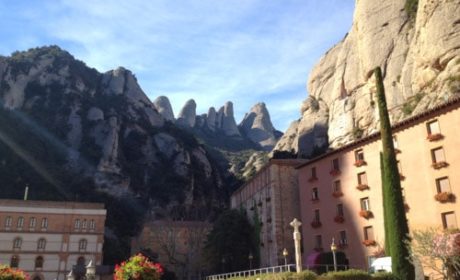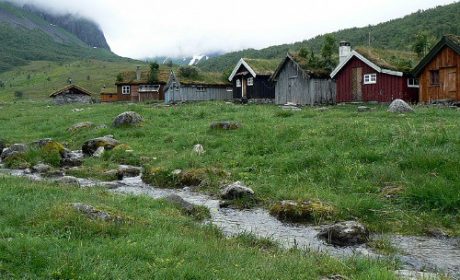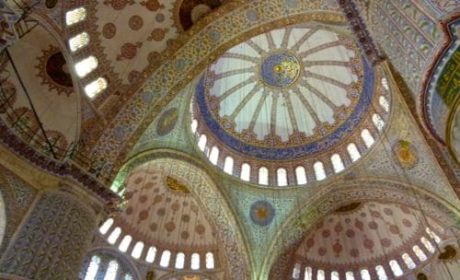Are you curious about what it’s like to go on a budget-friendly Greek Island cruise? You’re in luck because guest contributor Debi Lander, from ByLanderSea, is here to share her experience with us. Can you believe Alan and Donna still haven’t crossed cruising the Greek Islands off their boomer bucket list?
The Greek Islands are rich in the things boomers want from a vacation, but easier on the budget than many other cruise itineraries. Beautiful turquoise water, sandy beaches, adventure, mystery, romance, and the echoes of mythological Gods beckon.
In April 2018, Celestyal Cruises rolled out a new seven-day Aegean Island itinerary, the only cruise line offering an overnight in both Mykonos and Santorini. This schedule allows a slower paced journey around the islands as compared to other three and four-day cruises.

Plus, passengers may choose to linger for dramatic sunset dining atop volcanic Santorini or indulge in the famous nightlife on Mykonos. And they won’t have to worry about missing the boat.
Table of Contents
Life onboard Celestyal Crystal on a Greek Island Cruise
The Celestyal Crystal is a bit older ship, of medium size—carrying a maximum of 1,200 passengers. My stateroom could have used a little updating (a more modern duvet), but don’t let that discourage you.
This journey is much more about exploring the islands than the cruise ship. You’ll encounter a new adventure every day.
Beds, pillows and linens were very comfortable. Naturally, the bathroom is small but efficient. The shower lies at an angle but offers plenty of room within. A toilet and sink with a small amount of shelf space complete the bath.
The room steward cleaned the cabin twice daily. The lounges and dining areas are very inviting spaces, places where passengers come together, often making new friends.
Food is always available and plentiful. I ate some exceptionally good meals and others that were not so gourmet, but tasty.
I suggest picking the dining room over the buffets for less noise and better quality. Try the Greek specialties; the salads and olives are outstanding.
Greek Island Cruise itinerary for budget travelers
Below is a review of the Greek islands I visited, things I did, and sense of history gained. Many of the excursions offer an in-depth look at significant archaeological sites: the Palace of Knosos in Crete, the catacombs on Milos, and the Library of Celsus in Ephesus, Turkey. Passengers may choose the excursion in Ephesus or make a 12- hour stop on the island of Samos.
Mykonos: a jumping off point for an archaeological tour of Delos

Mykonos may be the glitziest of the Greek isles. It is often compared to Spain’s Ibiza for its vibrant nightlife.
As a boomer, I am not into late nightlife, so opted for a daytime tour of Delos. Reaching the tiny, uninhabited island required a half-hour ferryboat ride from Mykonos. (You pass the famous Mykonos windmills in the distance.)
Delos is one of Greece’s most important archeological sites. The island is famous as the mythical birthplace of twins Apollo and Artemis, and a place of pilgrimage.
Today, Delos lies in ruins, but its history humbles the many tourists it attracts. Our guide, an unemployed archeologist turned tour guide, was excellent.
We walked around the relics in the ancient city and what is left of the Sacred Way. The most compelling feature of the island was the Terrace of Lions. Built in the 7th century BC (yes, that far back), the lions paid honor to the Gods and acted as a symbol of wealth.
The modern Delos Archeological Museum houses an excellent collection of pottery, mosaics, statues and the original, but wind-eroded lions. Replicas of the marble lions replaced the originals in 1991. Delos is a haunting, desolate place, well worth a visit.
Explore Mykonos on your own:
- Delos guided tour from the cruise ship port
- Private guided tour of Delos from the cruise ship port
- Discover authentic Mykonos on a 4-hour tour
Boomer Travel Tip
MedjetAssist Members who are hospitalized 150 miles from home receive medical transport to a home-country hospital of choice. Memberships from $99.
Milos: finding nature and beautiful beaches

Milos is the kind of spot that excites a traveler: few crowds, mysterious landscape, incredible beaches, and the location where the famous statue named Venus de Milos was uncovered.

Sarakiniko Beach, hands down—the most-incredible beach I have ever seen, was created by a lava flow. Mother Nature’s powerful winds over the centuries have eroded the coastline forming mysterious and marvelous shapes.
It’s a lunar-like white/beige landscape, or something you might see in a Dr. Seuss book. The ecru colored mounds (not black lava) looked like sand but remain firm, not squishy. The beach was so unusual and appealing, I have a great desire to return.

Milos also has those quaint little Greek villages, ancient ruins, and a lot fewer people. For the moment, Milos remains a hidden gem for most Americans, but it is one I am sure you will hear more about and will want to add to the wish list. Celestyal is one of very few cruise ships that stop here, don’t miss Milos.

Explore Milos on your own:
- Enjoy a 5-hour catamaran cruise
- Sail the island on a catamaran with lunch
Santorini: dramatic beauty amidst the crowds

Everyone’s seen the classic images of Santorini: a cluster of whitewashed terraced houses clinging to high crimson cliffs—highlighted by marine blue church domes. Spectacular sunsets, black sand beaches, and legends of the lost continent of Atlantis add dramatic color and mystery to an already full palate.
The volcanic island’s wow factor just has to be seen and experienced in person. And it’s the reason that so many ships include Santorini on a Greek Island cruise itinerary.
First glimpse of the island makes you feel dwarfed. Santorini’s almost vertical cliff and its high, overhanging terraces look precarious. From the hilltop summit, even massive cruise ships look like toy boats in the harbor.
Passengers going ashore disembark from tender boats at the main harbor then choose the gondola, a donkey ride or a long hike some 885 feet up the zigzag path. The tourist-centric village of Fira nests at the top of the gondola run dangling like a fish on a hook.

An earthquake devastated Fira in 1956, but the persistent inhabitants rebuilt. Narrow alleyways and tight staircases squeeze between packed terraces of white stucco cave houses, small hotels, bars, and restaurants—some basic, some high-end.
Visitors may push on even higher as the panoramic views expand. The wide cliffside path provides swoon-inducing views, especially savored when you need to catch your breath.
The upper elevations dramatically showcase how today’s magnificent vista resulted from a violent volcanic eruption around 1450 BC. The harbor, with a single outlet to the Aegean, is large, underscoring the vast amount of land sunken into the sea by the tumultuous event. Photos don’t give justice to this panoramic swoosh.
Relaxing, shopping and dining reign as the main past times, but Santorini offers a lot more, with adventure options like sailing, snorkeling, swimming, and hiking. A favorite cruise excursion takes guests to the island of Nea Kameni, a place still vibrating with volcanic rumbles.
Participants hike lava-strewn trails amidst steaming volcanic vents and sulfur smells. I participated in this outing a few years back—finding it fascinating and invigorating.

Another excursion (one I didn’t choose) offered a tour of the archeological site of Akrotiri. Once a Minoan outpost, the settlement was buried in the ancient eruption and not unearthed until 1967. Those who took this excursion reassured me it was captivating.
Sunset cliffside dining ranks as a nightly Santorini ritual—a pinch-me moment made even lovelier by the sounds of live, traditional Greek music floating in the air.
Without question, Santorini is one of the most romantic spots in the world. But, those not looking for love will not be disappointed. This island satiates all the senses. Go see, touch, hear and taste the wonders of Santorini.
Explore Santorini on your own:
- Avoid some of the crowds on a 6-hour customizable private shore excursion
- Explore Nea Kameni on a private volcano tour and swim in the hot springs
- Enjoy a 2-hour private guided tour of Akrotiri
Crete: history dating back to the Bronze Age
The Greek island of Crete had one of the earliest civilizations dating back to the Bronze Age. The Minoan settlement employed skilled workers who built complex architectural marvels and created intricate artistic works.
The Palace of Knossos (purchase skip-the-line tours here), near Heraklion on Crete, provides the best and most important look at Minoan society. The first palace was built around 1900 BC, but an earthquake destroyed it some 200 years later. Soon afterward, the immense structure was rebuilt and almost everything remaining dates from the second build.

A fire destroyed the second palace, around 1370 BC. Its ruins were lost to the ages until excavations began in 1878.
Between 1900 and 1929, Sir Arthur Evans lead the restoration of some sections of the palace. As a tourist, I appreciated the opportunity to see and understand how the site may have looked in its glory. I absorbed a more powerful visual impression of Minoan Crete than could be gained from a mere outline of the foundation stones.
I took the palace tour as part of an excursion from my cruise. En-route via bus, our guide spoke about the history and magnificence of the location.
I soon saw what she meant! Grandeur, indeed. The enormous Palace of Knossos contained over 1,000 rooms and included an elaborate drainage system, flushing toilets, and paved roads. The Queen’s room added the luxury of an en-suite bath.
We also heard the legend of King Minos, who ruled the Palace. And the famed Minotaur he kept in the Labyrinth.
Highlights of the tour include the Grand Entryway, the Royal Apartments with copies of unearthed frescoes, and the Throne Room—with the original throne. Especially impressive is the still standing staircase – another original.
My group returned to the modern city to visit the Archeological Museum of Heraklion. It houses most of the palace’s priceless artifacts. The museum’s second floor maintains the stunning Knossos frescoes, eye-opening gems from the past. Scholars have gained many insights from these fragments of art.
Later in the day Cretan dancers performed onboard. The talented individuals displayed boundless energy and entrancing passion. The men dazzled with high jumps, kicks, and spins at a dizzying pace.
At the end of their performance, the audience joined in to learn a Greek Dance. I was chosen and fortunately picked up the steps rather quickly.
Explore Herkalion on your own:
- Ride the hop on-hop off bus in Herkalion
- Enjoy a private guided tour of Knossos Palace
- Experience a private foodie tour in Herkalion
Ephesus: walking through a UNESCO World Heritage site

The ancient world made Ephesus a center of travel and commerce. For a little over an hour, the UNESCO World Heritage site became the center of my world.
Read about Donna’s experience on an Ephesus cruise excursion.
The Greeks originally built Ephesus in the 10th century BC as commercial seaport, taking advantage of its strategic location. Over time, as river and port silted up, the waterways shifted.
The Ionian coast now rests several miles away. Having lost its access to the sea, Ephesus nevertheless continued to prosper under the Roman Empire (1st and 2nd centuries AD). Ephesus became the largest city in the East after Alexandria, with a population of over 200,000.
After leaving the port of Kusadasi, my Ephesus tour begins at the Magnesian Gate, near the top of a slope. Guides stop at significant points of interest: the remains of hundreds of temples, columns, statues, and etched drawings. I tried to imagine the bustling white marble city with residents in togas or flowing gowns.
We passed a theater used for council meetings, concerts or speeches. It could seat 1,400 and remains acoustically grand. Down colonnaded Curetes Street, we viewed the ruins of the Temples of Hadrian and Nike and the elaborate Nymphaeum Traiani Fountain.
We paused beside intricate mosaic floors from ancient homes along one side of the main path. We stopped, gawked and giggled at the men’s public toilet area. The area also housed a brothel.
Continuing down the marble Colonnade brought us to the majestic two-storied Library of Celsus, the highlight of excavated Ephesus, and originally built in 117 AD. The structure stands proudly at the base of the slope and features statuary copies of the originals.
After extensive site work in the 1960-70’s, Austrian archeologists re-erected many of the finely chiseled columns. Their work lets you feel the grandeur and size of the original building. In its prime, the library housed 12,000 parchment manuscripts and scrolls.
As you approach the immense amphitheater or Great Theater, you can almost hear the noise of a crowd. The Romans enlarged the seating, up to 25,000 people, and added blood sports that included gladiator fights. The nearly intact stadium stands as a marvel of ancient glory and memorial to all those who died there.
According to experts only 13% of the ancient site has been excavated and studied, leaving much more work to be done and more wonders to uncover.
Explore Ephesus and Kusadasi on your own
- Private Ephesus tour with lunch. Departs from Kusadasi
- Private Ephesus tour that includes the House of Mary. Departs from Kusadasi
- Experience a Hamam Turkish Bath in Kusadasi (if you’ve already seen Ephesus)
Athens: the beginning and the ending plus more to see

The ship embarks and returns to Piraeus, a suburb of Athens. Since you fly in and out of Athens airport (check for the best flight prices here), it makes sense to add on a day to see the sites of Athens (two is preferable.) Here’s a good starting point for finding hotels in Athens.
And what should you see? The Acropolis, Acropolis Museum and National Archeological Museum contain priceless antiquities that are not to be missed.
I signed up online for the Athens Free Walking Tour and it was one of the best-guided tours I have ever experienced. Simply tip the guide at the end.
If you are considering a Greek getaway, the Greek isles add authentic experiences as well as a rich sense of Greek culture and history.
What to pack for a cruise in the Greek Islands?
It’s hot in the Greek Islands, especially during summer cruises. To look good but beat the heat, pack a few of Donna’s favorites:
- Loose, flowing dresses or skirts
- Cute walking sandals to wear off or on the ship
- A packable hat to protect your skin and hair from strong sun.
You’ll find more tips in Surviving a Summer Cruise in the Mediterranean.
Save to Pinterest




